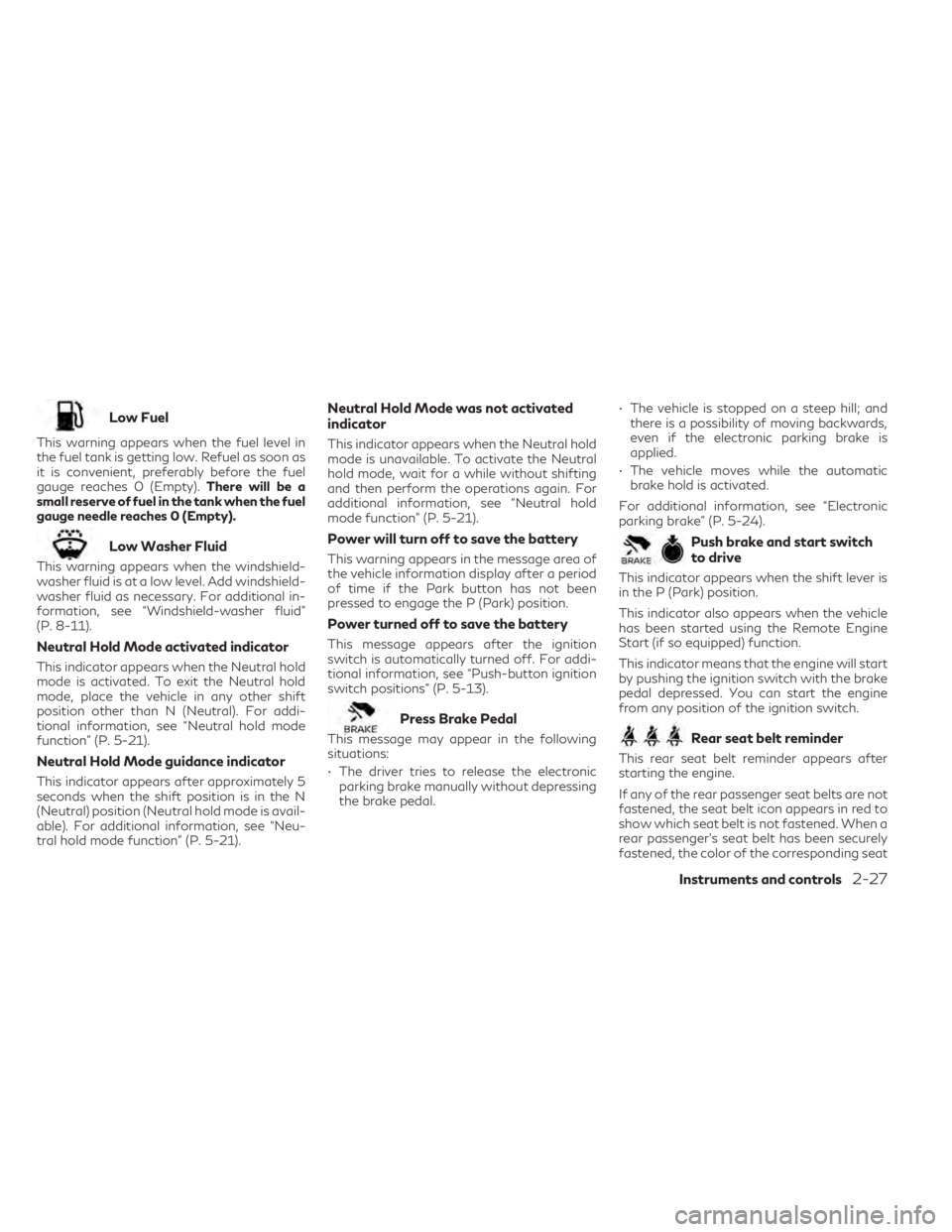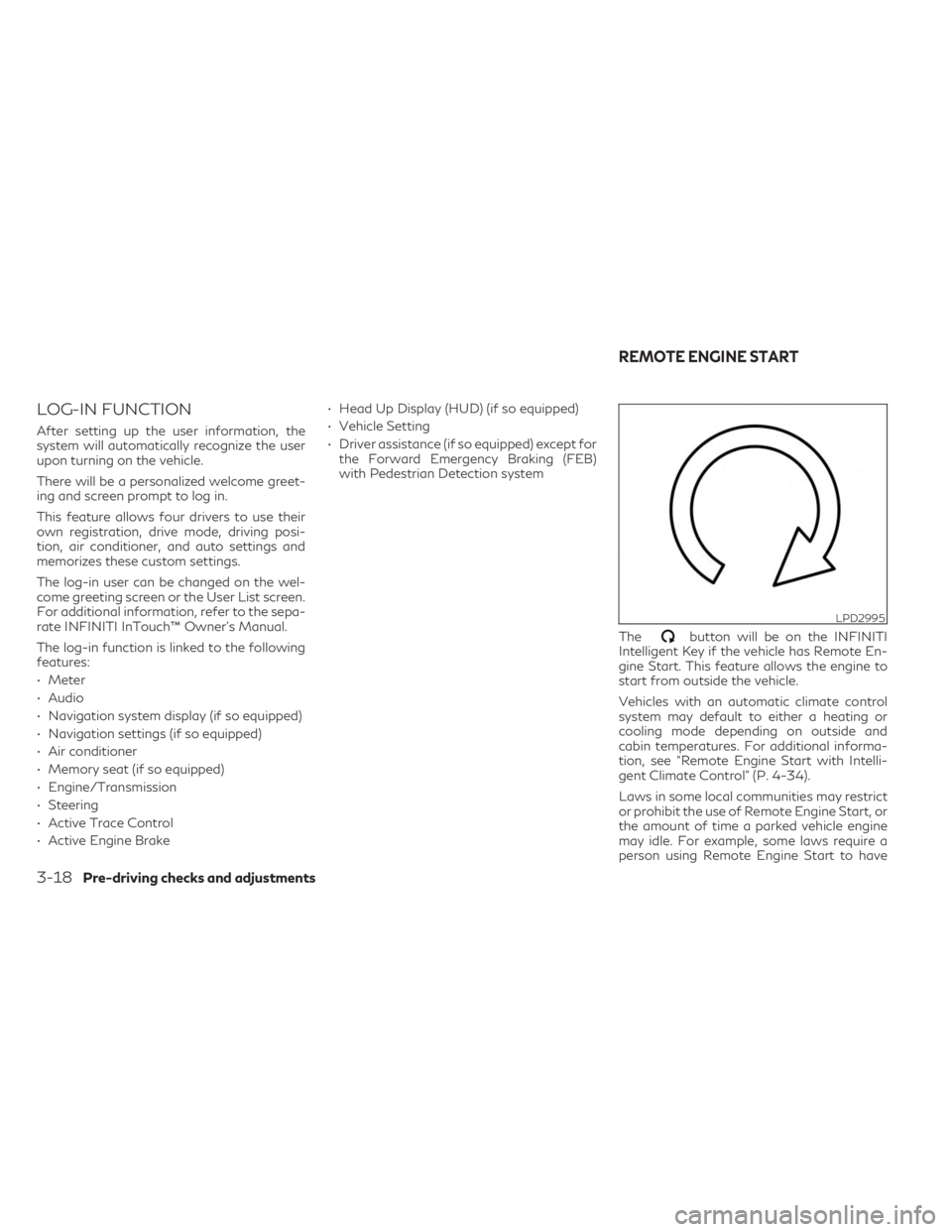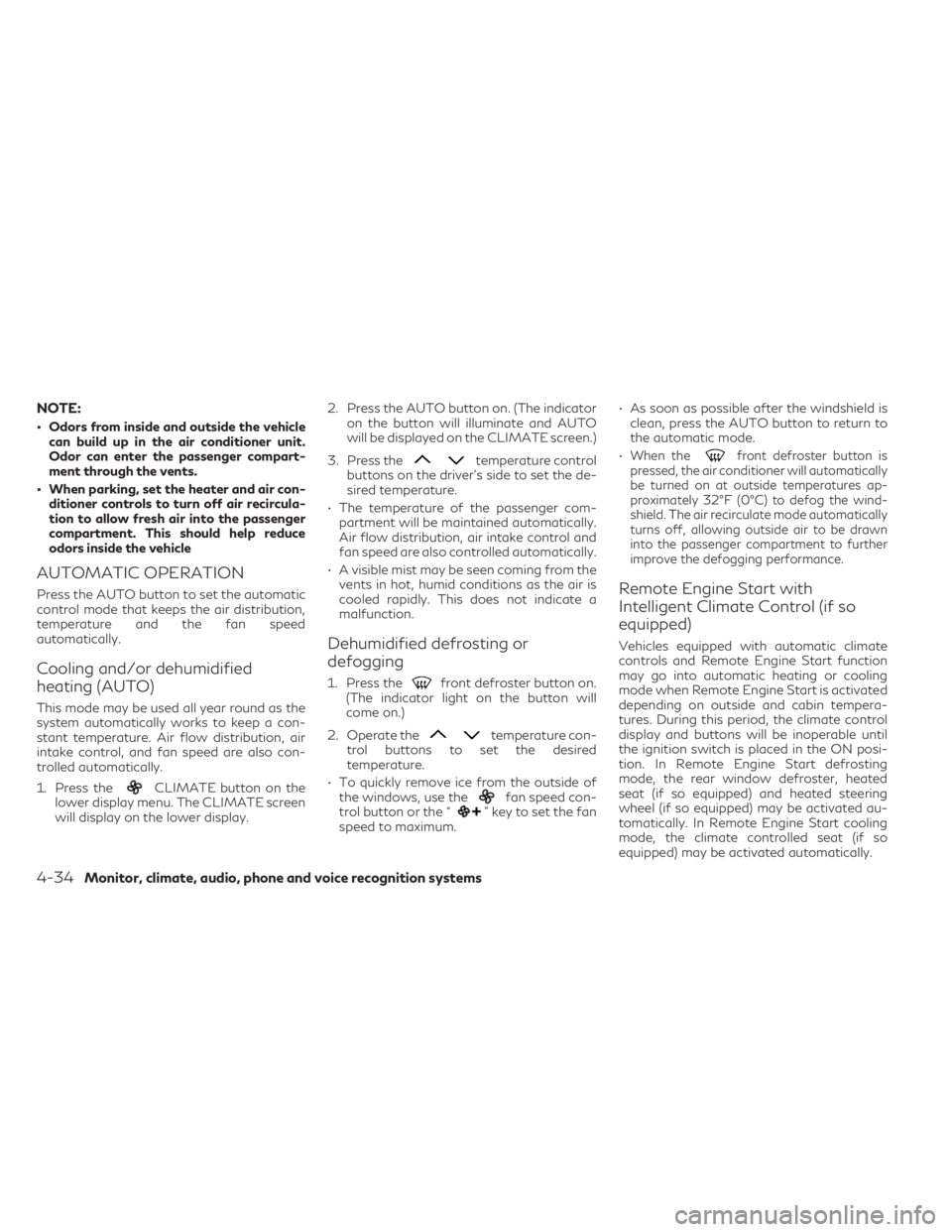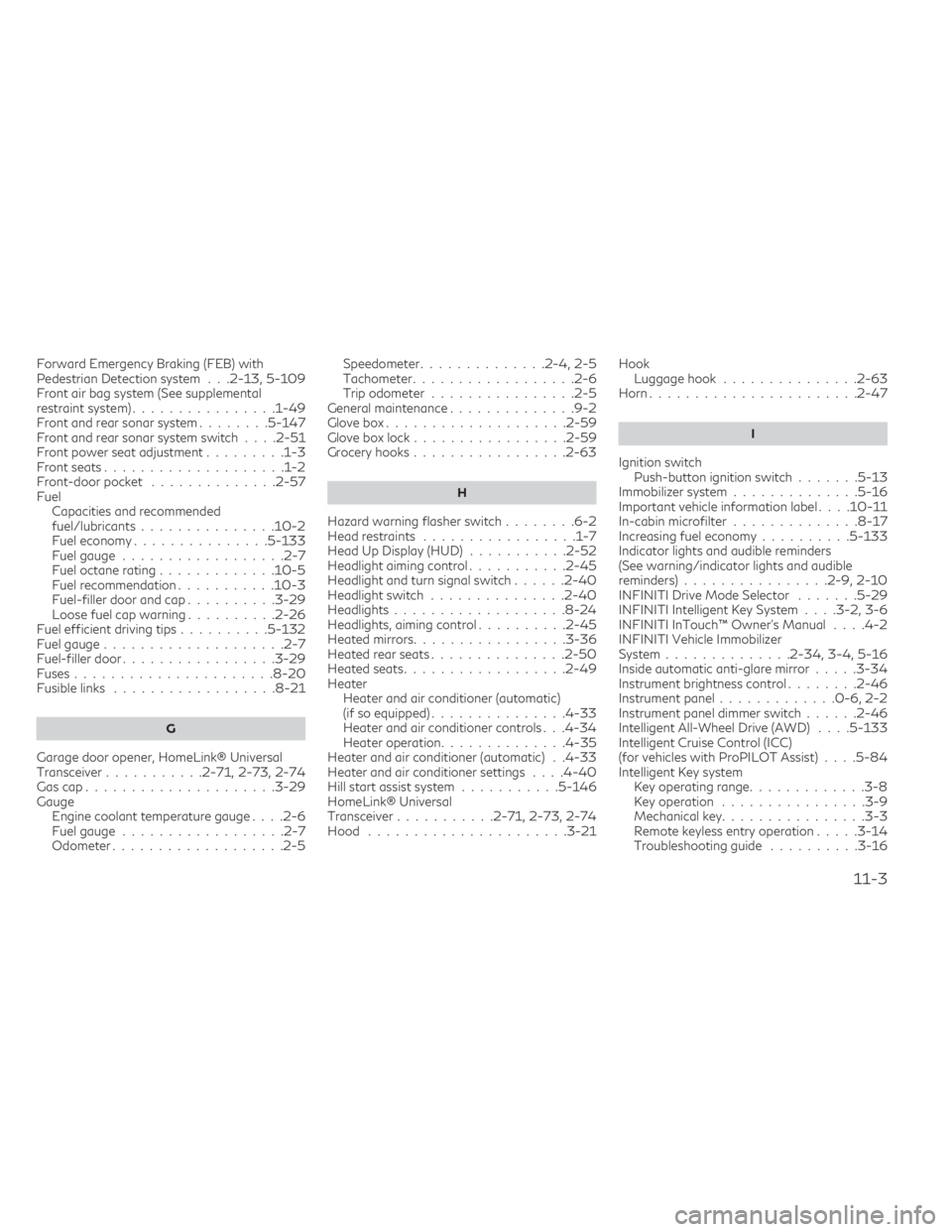remote control INFINITI QX55 2023 Owners Manual
[x] Cancel search | Manufacturer: INFINITI, Model Year: 2023, Model line: QX55, Model: INFINITI QX55 2023Pages: 526, PDF Size: 5.75 MB
Page 93 of 526

FUEL GAUGE
The gauge indicates theapproximatefuel
level in the tank.
The gauge may move slightly during braking,
turning, acceleration, or going up or down
hills.
The gauge needle returns to 0 (Empty) after
the ignition switch is placed in the OFF
position.
The low fuel warning comes on when the
amount of fuel in the tank is getting low. Refill the fuel tank once the Low Fuel
warning indicator in the vehicle information
display illuminates as indicated by
Low
Fuel.
The
indicates that the fuel-filler door is
located on the driver's side of the vehicle.
CAUTION
• If the vehicle runs out of fuel, the
Malfunction Indicator Light (MIL) may
come on. Refuel as soon as possible. Af-
ter a few driving trips. the
light
should turn off. If the light remains on
after a few driving trips, have the vehicle
inspected. It is recommended that you
visit an INFINITI retailer for this service.
• For additional information, see “Mal-
function Indicator Light (MIL)”
(P. 2-15).
DISTANCE TO EMPTY (DTE)
Displays the estimated distance the vehicle
can be driven before refueling. The value is
calculated based on recent fuel economy, the
amount of fuel remaining in the fuel tank, and
the actual fuel consumption. Changes in driving patterns or conditions can
cause the DTE value to vary. As a result, the
value displayed may differ from the actual
distance that can be driven.
DTE display will change to “---” when the fuel
level in the tank is getting low, prior to the fuel
gauge reaching 0 (Empty).
NOTE:
• The DTE value after refill is estimated
based on recent fuel economy and amount
of fuel added.
• If a small amount of fuel is added, or the ignition is on during refueling, the display
may not be updated.
• Conditions that affect the fuel economy will also affect the estimated DTE value
(city/highway driving, idle time, remote
start time, terrain, seasonal weather,
added vehicle weight, added deflectors,
roof racks, etc.).
LIC3851
Instruments and controls2-7
Page 113 of 526

Low Fuel
This warning appears when the fuel level in
the fuel tank is getting low. Refuel as soon as
it is convenient, preferably before the fuel
gauge reaches 0 (Empty).There will be a
small reserve of fuel in the tank when the fuel
gauge needle reaches 0 (Empty).
Low Washer Fluid
This warning appears when the windshield-
washer fluid is at a low level. Add windshield-
washer fluid as necessary. For additional in-
formation, see “Windshield-washer fluid”
(P. 8-11).
Neutral Hold Mode activated indicator
This indicator appears when the Neutral hold
mode is activated. To exit the Neutral hold
mode, place the vehicle in any other shift
position other than N (Neutral). For addi-
tional information, see “Neutral hold mode
function” (P. 5-21).
Neutral Hold Mode guidance indicator
This indicator appears after approximately 5
seconds when the shift position is in the N
(Neutral) position (Neutral hold mode is avail-
able). For additional information, see “Neu-
tral hold mode function” (P. 5-21).
Neutral Hold Mode was not activated
indicator
This indicator appears when the Neutral hold
mode is unavailable. To activate the Neutral
hold mode, wait for a while without shifting
and then perform the operations again. For
additional information, see “Neutral hold
mode function” (P. 5-21).
Power will turn off to save the battery
This warning appears in the message area of
the vehicle information display after a period
of time if the Park button has not been
pressed to engage the P (Park) position.
Power turned off to save the battery
This message appears after the ignition
switch is automatically turned off. For addi-
tional information, see “Push-button ignition
switch positions” (P. 5-13).
Press Brake Pedal
This message may appear in the following
situations:
• The driver tries to release the electronic parking brake manually without depressing
the brake pedal. • The vehicle is stopped on a steep hill; and
there is a possibility of moving backwards,
even if the electronic parking brake is
applied.
• The vehicle moves while the automatic brake hold is activated.
For additional information, see “Electronic
parking brake” (P. 5-24).
Push brake and start switch
to drive
This indicator appears when the shift lever is
in the P (Park) position.
This indicator also appears when the vehicle
has been started using the Remote Engine
Start (if so equipped) function.
This indicator means that the engine will start
by pushing the ignition switch with the brake
pedal depressed. You can start the engine
from any position of the ignition switch.
Rear seat belt reminder
This rear seat belt reminder appears after
starting the engine.
If any of the rear passenger seat belts are not
fastened, the seat belt icon appears in red to
show which seat belt is not fastened. When a
rear passenger’s seat belt has been securely
fastened, the color of the corresponding seat
Instruments and controls2-27
Page 169 of 526

•Make sure to engage the P (Park) posi-
tion and apply the parking brake when
parking your vehicle, riding on or off the
vehicle or loading luggage. Failure to do
so could cause the vehicle to move or roll
away unexpectedly and result in serious
personal injury or property damage.
The Intelligent Key system can operate all the
door locks using the remote control function
or pushing the request switch on the vehicle
without taking the key out from a pocket or
purse. The operating environment and/or
conditions may affect the Intelligent Key sys-
tem operation.
Be sure to read the following before using the
Intelligent Key system.
CAUTION
• Be sure to carry the Intelligent Key with
you when operating the vehicle.
• Never leave the Intelligent Key in the ve-
hicle when you leave the vehicle.
The Intelligent Key is always communicating
with the vehicle as it receives radio waves.
The Intelligent Key system transmits weak
radio waves. Environmental conditions may interfere with the operation of the Intelligent
Key system under the following operating
conditions:
• When operating near a location where
strong radio waves are transmitted, such as
a TV tower, power station and broadcast-
ing station.
• When in possession of wireless equipment, such as a cellular telephone, transceiver or
a CB radio.
• When the Intelligent Key is in contact with or covered by metallic materials.
• When any type of radio wave remote con- trol is used nearby.
• When the Intelligent Key is placed near an electric appliance such as a personal
computer.
• When the vehicle is parked near a parking meter.
In such cases, correct the operating condi-
tions before using the Intelligent Key function
or use the mechanical key.
Although the life of the battery varies de-
pending on the operating conditions, the bat-
tery’s life is approximately two years. If the
battery is discharged, replace it with a new
one. When the Intelligent Key battery is low, a
“Key Battery Low” indicator appears in the
vehicle information display. For additional in-
formation, see “Vehicle information display
warnings and indicators” (P. 2-25).
Since the Intelligent Key is continuously re-
ceiving radio waves, if the key is left near
equipment which transmits strong radio
waves, such as signals from a TV and per-
sonal computer, the battery life may become
shorter.
For additional information, see “Battery re-
placement” (P. 8-22).
CAUTION
Listed below are conditions or occurrences
which will damage the Intelligent Key:
• Do not allow the Intelligent Key, which
contains electrical components, to come
into contact with water or salt water.
This could affect the system function.
• Do not drop the Intelligent Key.
• Do not strike the Intelligent Key sharply
against another object.
• Do not change or modify the Intelligent
Key.
Pre-driving checks and adjustments3-7
Page 180 of 526

LOG-IN FUNCTION
After setting up the user information, the
system will automatically recognize the user
upon turning on the vehicle.
There will be a personalized welcome greet-
ing and screen prompt to log in.
This feature allows four drivers to use their
own registration, drive mode, driving posi-
tion, air conditioner, and auto settings and
memorizes these custom settings.
The log-in user can be changed on the wel-
come greeting screen or the User List screen.
For additional information, refer to the sepa-
rate INFINITI InTouch™ Owner’s Manual.
The log-in function is linked to the following
features:
• Meter
• Audio
• Navigation system display (if so equipped)
• Navigation settings (if so equipped)
• Air conditioner
• Memory seat (if so equipped)
• Engine/Transmission
• Steering
• Active Trace Control
• Active Engine Brake• Head Up Display (HUD) (if so equipped)
• Vehicle Setting
• Driver assistance (if so equipped) except for
the Forward Emergency Braking (FEB)
with Pedestrian Detection system
The
button will be on the INFINITI
Intelligent Key if the vehicle has Remote En-
gine Start. This feature allows the engine to
start from outside the vehicle.
Vehicles with an automatic climate control
system may default to either a heating or
cooling mode depending on outside and
cabin temperatures. For additional informa-
tion, see “Remote Engine Start with Intelli-
gent Climate Control” (P. 4-34).
Laws in some local communities may restrict
or prohibit the use of Remote Engine Start, or
the amount of time a parked vehicle engine
may idle. For example, some laws require a
person using Remote Engine Start to have
LPD2995
REMOTE ENGINE START
3-18Pre-driving checks and adjustments
Page 181 of 526

the vehicle in view or may restrict idling time
except in freezing temperatures. Check local
regulations for any requirements.
Other conditions may affect the function of
the Remote Engine Start feature. For addi-
tional information, see “Conditions the Re-
mote Engine Start will not work” (P. 3-20).
Other conditions can affect the performance
of the Intelligent Key transmitter. For addi-
tional information, see “INFINITI Intelligent
Key system” (P. 3-6).
REMOTE ENGINE START
OPERATING RANGE
WARNING
• To help avoid risk of injury or death
through unintended operation of the ve-
hicle and/or its systems, including en-
trapment in windows or inadvertent
door lock activation, do not leave chil-
dren, people who require the assistance
of others or pets unattended in your ve-
hicle. Additionally, the temperature in-
side a closed vehicle on a warm day can
quickly become high enough to cause a
significant risk of injury or death to
people and pets. •
Do not use Remote Engine Start in closed
spaces such as a garage. Do not breathe
exhaust gases; they contain colorless
and odorless carbon monoxide. Carbon
monoxide is dangerous. It can cause un-
consciousness or death.
CAUTION
When the Intelligent Key battery is dis-
charged or other strong radio wave
sources are present near the operating lo-
cation, the Intelligent Key operating range
becomes narrower, and the Intelligent Key
may not function properly.
The Remote Engine Start function can only
be used when the Intelligent Key is within the
specified operating range from the vehicle.
The Remote Engine Start operating range is
approximately 197 ft (60 m) from the vehicle.
REMOTE STARTING THE
VEHICLE
To use the Remote Engine Start feature per-
form the following:
1. Aim the Intelligent Key at the vehicle.
2. Press the
button to lock all doors.
3. Within 5 seconds press and hold the
button until the turn signal lights flash and
the tail lamps turn on. If the vehicle is not
within view press and hold the
but-
ton for at least 2 seconds.
The following events will occur when the en-
gine starts:
• The parking lights will turn on and remain on as long as the engine is running.
• The doors will be locked and the climate control system may come on.
• The engine will continue to run for 10 min- utes. Repeat the steps to extend the time
for an additional 10 minutes. For additional
information, see “Extending engine run
time” (P. 3-20).
Press and hold the brake pedal while switch-
ing the ignition to the ON position before
driving. For additional information, see “Driv-
ing the vehicle” (P. 5-18).
Pre-driving checks and adjustments3-19
Page 197 of 526

NOTE:
Do not hang any objects over the sensorsO1
or apply glass cleaner to the sensors. Doing
so will reduce the sensitivity of the sensors,
resulting in improper operation.
The indicator light
O2will illuminate when the
automatic anti-glare feature is operating.
To turn off the automatic anti-glare feature,
press the O button. The indicator light will
turn off.
To turn on the automatic anti-glare feature
again, press the | button again. The indica-
tor light will turn on.
For additional information on HomeLink®
Universal Transceiver operation, see
“HomeLink® Universal Transceiver” (P. 2-71).
OUTSIDE MIRRORS
The outside mirror remote control will oper-
ate only when the ignition switch is in the ON
position.
Move the small switch
O1to select the left or
right mirror. Adjust each mirror to the desired
position using the large switch
O2. Move the
small switch
O1to the center (neutral) posi-
tion to prevent accidentally moving the
mirror.
WARNING
• Objects viewed in the outside mirror on
the passenger side are closer than they
appear. Be careful when moving to the
right. Using only this mirror could cause
an accident. Use the inside mirror or
glance over your shoulder to properly
judge distances to other objects.
• Do not adjust the mirrors while driving.
You could lose control of your vehicle and
cause an accident.
LPD3035
Pre-driving checks and adjustments3-35
Page 236 of 526

NOTE:
• Odors from inside and outside the vehiclecan build up in the air conditioner unit.
Odor can enter the passenger compart-
ment through the vents.
• When parking, set the heater and air con- ditioner controls to turn off air recircula-
tion to allow fresh air into the passenger
compartment. This should help reduce
odors inside the vehicle
AUTOMATIC OPERATION
Press the AUTO button to set the automatic
control mode that keeps the air distribution,
temperature and the fan speed
automatically.
Cooling and/or dehumidified
heating (AUTO)
This mode may be used all year round as the
system automatically works to keep a con-
stant temperature. Air flow distribution, air
intake control, and fan speed are also con-
trolled automatically.
1. Press the
CLIMATE button on the
lower display menu. The CLIMATE screen
will display on the lower display. 2. Press the AUTO button on. (The indicator
on the button will illuminate and AUTO
will be displayed on the CLIMATE screen.)
3. Press the
temperature control
buttons on the driver’s side to set the de-
sired temperature.
• The temperature of the passenger com- partment will be maintained automatically.
Air flow distribution, air intake control and
fan speed are also controlled automatically.
• A visible mist may be seen coming from the vents in hot, humid conditions as the air is
cooled rapidly. This does not indicate a
malfunction.
Dehumidified defrosting or
defogging
1. Press thefront defroster button on.
(The indicator light on the button will
come on.)
2. Operate the
temperature con-
trol buttons to set the desired
temperature.
• To quickly remove ice from the outside of the windows, use the
fan speed con-
trol button or the “” key to set the fan
speed to maximum. • As soon as possible after the windshield is
clean, press the AUTO button to return to
the automatic mode.
•
When thefront defroster button is
pressed, the air conditioner will automatically
be turned on at outside temperatures ap-
proximately 32°F (0°C) to defog the wind-
shield. The air recirculate mode automatically
turns off, allowing outside air to be drawn
into the passenger compartment to further
improve the defogging performance.
Remote Engine Start with
Intelligent Climate Control (if so
equipped)
Vehicles equipped with automatic climate
controls and Remote Engine Start function
may go into automatic heating or cooling
mode when Remote Engine Start is activated
depending on outside and cabin tempera-
tures. During this period, the climate control
display and buttons will be inoperable until
the ignition switch is placed in the ON posi-
tion. In Remote Engine Start defrosting
mode, the rear window defroster, heated
seat (if so equipped) and heated steering
wheel (if so equipped) may be activated au-
tomatically. In Remote Engine Start cooling
mode, the climate controlled seat (if so
equipped) may be activated automatically.
4-34Monitor, climate, audio, phone and voice recognition systems
Page 515 of 526

Forward Emergency Braking (FEB) with
Pedestrian Detection system. . .2-13, 5-109Front air bag system (See supplemental
restraint system)................1-49Front and rear sonar system........5-147Front and rear sonar system switch. . . .2-51Front power seat adjustment.........1-3Front seats................... .1-2Front-door pocket..............2-57Fuel
Capacities and recommended
fuel/lubricants
.............. .10-2Fuel economy...............5-133Fuel gauge................. .2-7Fuel octane rating.............10-5Fuel recommendation...........10-3Fuel-filler door and cap..........3-29Loose fuel cap warning..........2-26Fuel efficient driving tips..........5-132Fuel gauge................... .2-7Fuel-filler door.................3-29Fuses..................... .8-20Fusible links..................8-21
G
Garage door opener, HomeLink® Universal
Transceiver...........2-71, 2-73, 2-74Gas cap.................... .3-29Gauge
Engine coolant temperature gauge. . . .2-6Fuel gauge................. .2-7Odometer.................. .2-5
Speedometer..............2-4, 2-5Tachometer................. .2-6Trip odometer................2-5General maintenance..............9-2Glove box................... .2-59Glove box lock.................2-59Grocery hooks.................2-63
H
Hazard warning flasher switch........6-2Head restraints.................1-7Head Up Display (HUD)...........2-52Headlight aiming control...........2-45Headlight and turn signal switch......2-40Headlight switch.............. .2-40Headlights.................. .8-24Headlights, aiming control..........2-45Heated mirrors.................3-36Heated rear seats...............2-50Heated seats................. .2-49Heater
Heater and air conditioner (automatic)
(if so equipped)
.............. .4-33Heater and air conditioner controls. . .4-34Heater operation..............4-35Heater and air conditioner (automatic). .4-33Heater and air conditioner settings. . . .4-40Hill start assist system...........5-146HomeLink® Universal
Transceiver...........2-71, 2-73, 2-74Hood..................... .3-21
Hook
Luggage hook.............. .2-63Horn...................... .2-47
I
Ignition switch
Push-button ignition switch.......5-13Immobilizer system............. .5-16Important vehicle information label. . . .10-11In-cabin microfilter..............8-17Increasing fuel economy..........5-133Indicator lights and audible reminders
(See warning/indicator lights and audible
reminders)
............... .2-9, 2-10INFINITI Drive Mode Selector.......5-29INFINITI Intelligent Key System. . . .3-2, 3-6INFINITI InTouch™ Owner's Manual. . . .4-2INFINITI Vehicle Immobilizer
System..............2-34, 3-4, 5-16Inside automatic anti-glare mirror. . . . .3-34Instrument brightness control........2-46Instrument panel.............0-6, 2-2Instrument panel dimmer switch......2-46Intelligent All-Wheel Drive (AWD). . . .5-133Intelligent Cruise Control (ICC)
(for vehicles with ProPILOT Assist). . . .5-84Intelligent Key system
Key operating range............ .3-8Key operation............... .3-9Mechanical key................3-3Remote keyless entry operation.....3-14Troubleshooting guide..........3-16
11-3